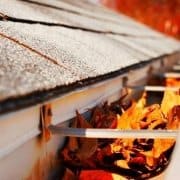Why Fixing Wood Rot Around Your Home is Crucial!
Rotted wood is a big issue that often goes under a homeowner’s radar—until it’s too late. Fixing wood rot around your home before it escalates should be a top priority!
Leaky window frames or cracking sills indicate wood rot around windows, but they’re also a sign that the problem is worse than you think. Here’s what you need to know to prevent wood rot before it destroys your windowsills, door frames, or foundation and becomes an expensive problem.

What Causes Rotten Wood?
The short answer is that moisture causes wood to rot. Windows are built to withstand and protect your home from the effects of weather. However, improper window installation can lead to water damage. Other causes can stem from poor siding installation, bad roof replacement or roofing damage, or gutter issues. When water doesn’t flow away from your home correctly, it can seep into windowsills and cause rot (which is why professionals should handle these big home updates).
As with many home problems, the best way to deal with wood rot is to keep it from happening in the first place. The second best way is to catch it in the early stages and work quickly to address the affected area. If you notice signs of wood rot around your window sills, exterior doors, or anywhere on the exterior of your home, it’s a good idea to call a professional to replace the window and assess the extent of the damage to make sure it’s not spreading to the surrounding area.
When windows are well-installed, preventative measures are taken to avoid wood rot. Flashing protects the window frame from moisture and leakage along the top, allowing water to drain over and away from the window. If the flashing is damaged or missing, water sits atop the window casing and gets into the frame over time. When not adequately drained, water may also leak into the walls or posts of the house and lead to an even more significant wet rot issue.
Where there is a source of moisture, there can also be pests. Carpenter ants, termites, and other bugs find these cool, damp areas ideal for setting up their homes. When these critters get into your exterior wood, you often need professional assistance to address the problem, as they tend to eat away at the affected wood and move into other areas of your home. If you treat the infestation soon enough, you’ll prevent lasting damage to the woodwork in your home.
When combined, pests and water lead to the perfect storm of damage around windows, vents, and doors. Any area of your home with wood trim may experience this problem, but window frames are regularly exposed to high humidity, making them highly susceptible to rot and damage. Challenges with your siding (away from windows) can also create an escape zone for water to seep into, creating similar challenges.
Unfortunately, wood rot may go on for years before a homeowner notices the problem. When you realize there’s an infestation or wood rot problem, it may be too late for a minor intervention or making simple wood rot repairs. You may need to replace your windows and tear out the sill and frame entirely, replace full siding, or even worse, need structural changes and updates.
If you’re worried about the issue of wood rot around your home—in your windows, siding, or doors—the first step is to take a few moments to examine your home for the early signs of wood rot.
Knowing the Signs of Wood Rot Around Your Home
Recently, we worked with a homeowner who had a big problem with wood rot in their door and windows that another company replaced. When we arrived to assess the situation, we noticed some paint peeling and chipping in the corner (very minimal). Still, we know that is generally a sign of an underlying issue.
Upon further exploration, we found that the problem stemmed from a faulty gutter with multiple seams and a poorly constructed, flat rubber roof allowing water to pool. Water was leaking in behind the siding and running into the frame. Carpenter ants feasting on the rotting wood had compounded the problem. As we investigated, we were amazed that the corner of the roof was still standing, seeing as there was so much rot.
Here’s a special Tod & Todd’s Home Improvement Tips video, where we show the window damage this homeowner sustained from wood rot:
Don’t let this problem happen to you! It’s a significant expense; homeowners often must replace their windows, doors, and/or siding entirely. If you don’t fix the root cause (gutters, roofing, framing issues, etc.), the problem will likely occur again. Wood rot is one problem that is best addressed early on, at the first sign of an issue. It can significantly impact structural stability and isn’t just limited to older homes.
Inspect the windowsills and frames to check for signs of rot damage around your home. Are there any cracks or degraded-looking areas? If there are small holes or spots where the wood is crumbling, then there’s a good chance you have a problem.
Watch for signs of mildew as well. While most windows have some normal condensation, it should accumulate inside your windows. Preventing condensation with a dehumidifier, fan, or proper ventilation may be necessary. If your windows accumulate a lot of condensation, the damp conditions can lead to damage on the surface of the wood. Condensation or fogging should never build up between windowpanes; this indicates seal failure.
The primary cause of wood rot around windows, doors, and siding is water running toward your home. If you notice gutters dripping water on your windows, at the base of your doors, or even down your siding, intervene right away. Other signs include paint bubbling or a window frame that seems constantly damp, fungal growth, or discolored mold. Improper flashing, older siding, and leaky gutters result in water pooling and buildup beneath your house’s exterior trim. Water should never, ever leak into your home, either. Find the water sources and take steps to stop them right away.
Another indication of damaged wood is carpenter ants or termites. If you start seeing ants in your home, there’s a hole somewhere. Follow these visitors to their origin and address the problem head-on before leading to further damage. Ants can wreak havoc before you realize they live in your wood trim.
Lastly, if you see a discolored spot, take a pencil or pen and press on the spot. If the piece of wood has give or seems soft, it indicates a rotting area is likely in the soft wood underneath from water damage.
The remedy is often simple if homeowners watch for the signs and address them very early. You may need to repair a gutter, fix the flashing, or hire a professional to exterminate the pests. It’s imperative to correct the issue ASAP. Any sign of damp wood, even in a small area, is a concern that shouldn’t wait.
Unfortunately, wood rot in one window or spot is rarely isolated, so stay diligent when watching for wood rot around your home. If you notice a small problem or a few areas of decay, call us immediately. Don’t wait! Rotted materials can become a health hazard and a threat to the structural integrity of your home.
Your Weather Tight expert will help you assess the issue and mitigate the damage your home has sustained. If it’s a quick fix, we’ll walk you through the solution. We will also help you decide if it’s time for replacement products or home remodeling. Weather Tight doesn’t specialize in repair work, but often, when an issue becomes noticeable, replacement products are needed, and we are happy to help you address what you may need.
Your home is your castle. Don’t let it crumble due to wood rot. Tackle it right away by calling Weather Tight today!

 414-459-3874
414-459-3874






















 Text Us!
Text Us!

